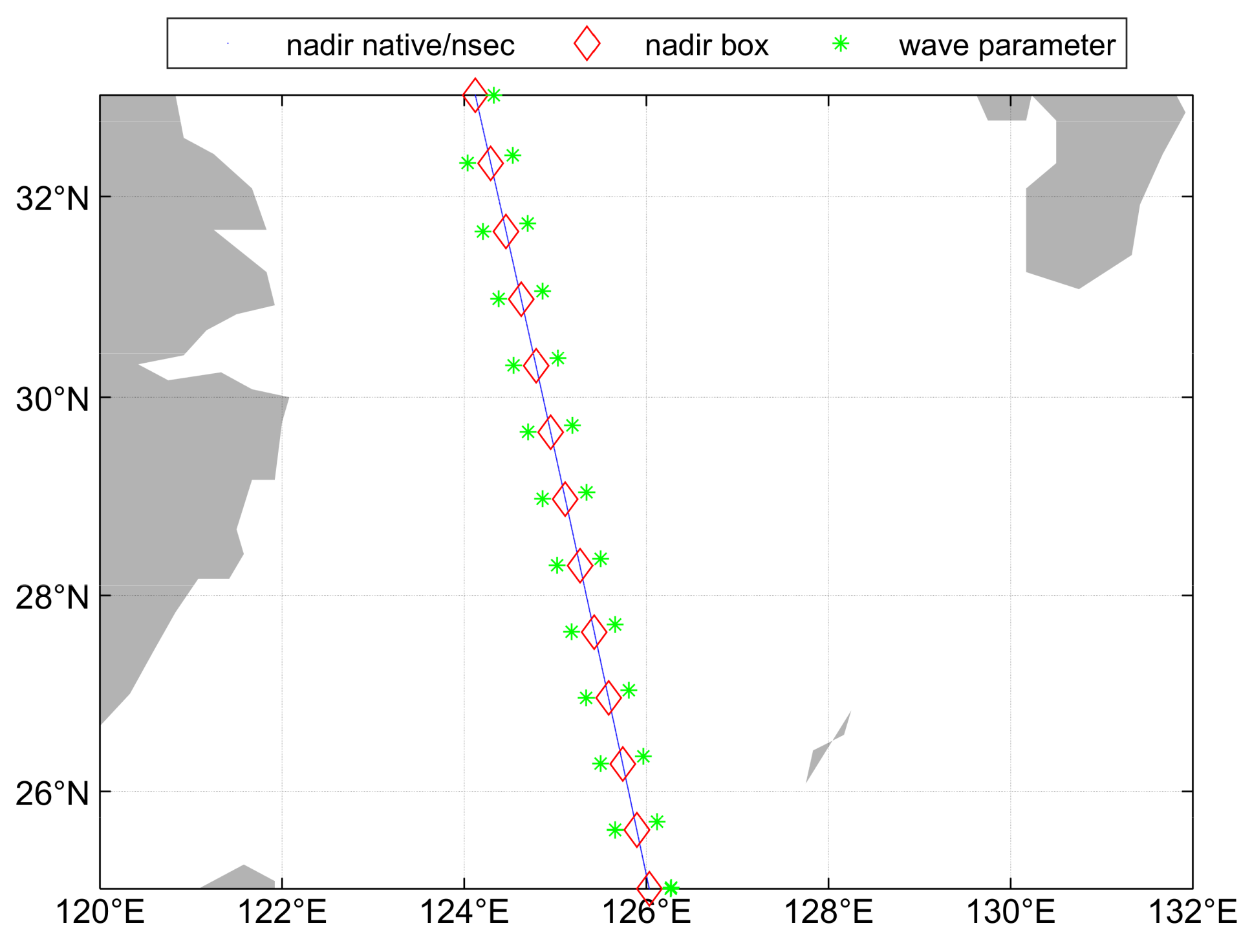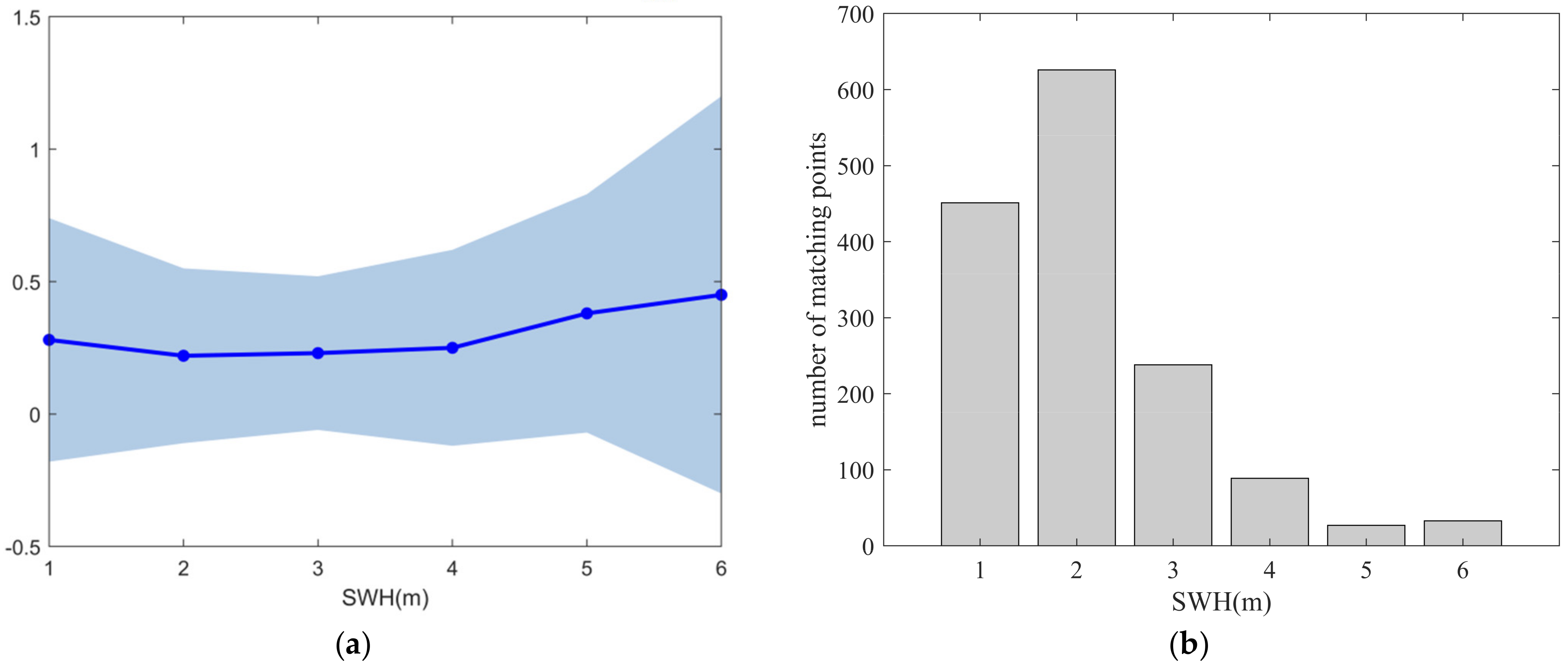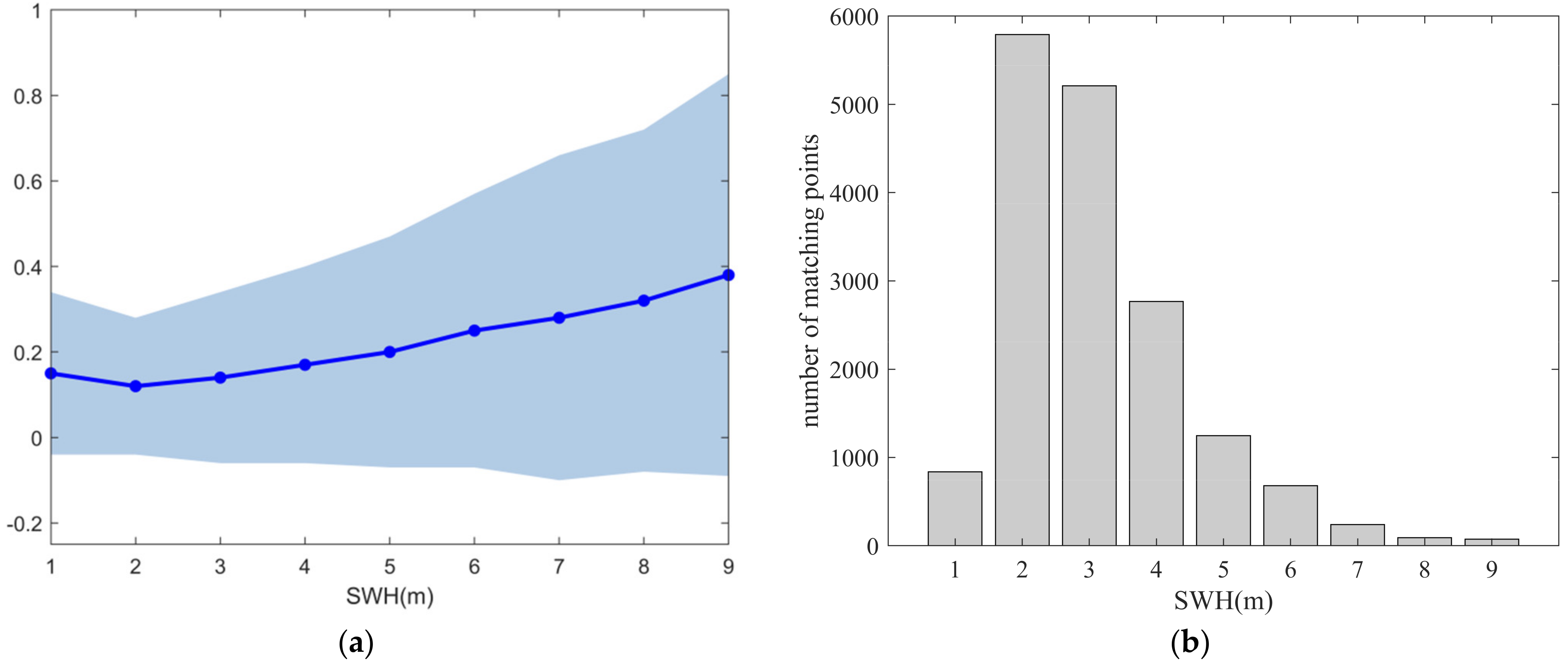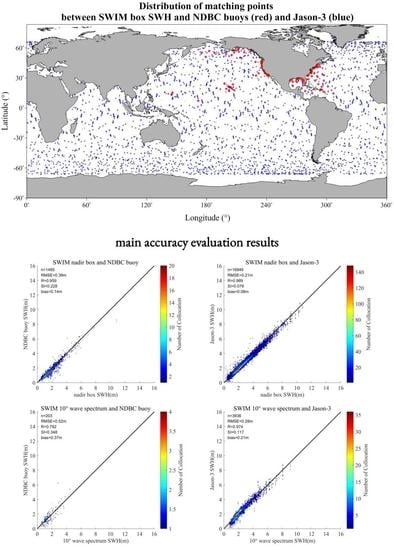Accuracy Evaluation of CFOSAT SWIM L2 Products Based on NDBC Buoy and Jason-3 Altimeter Data
Abstract
:1. Introduction
2. Materials and Methods
2.1. Data
2.1.1. SWIM Spectrometer Data
2.1.2. NDBC Buoy Data
2.1.3. Jason-3 Altimeter Data
2.2. Methods
3. Nadir SWIM SWH Accuracy Evaluation
3.1. Comparison with NDBC Buoy
3.2. Comparison with Jason-3 Altimeter
4. Off-nadir SWIM Wave Parameter Accuracy Evaluation
4.1. Comparison of SWH with NDBC Buoy and Jason-3 Altimeter
4.2. Comparison of Dominant Direction with NDBC Buoy
5. Conclusions
- (1)
- For SWIM nadir SWH data, the accuracy of nsec and box data is better than that of native data. The accuracy of box SWH data is further promoted after quality control, and the RMSE are 0.39 and 0.21 m compared with NDBC buoy and Jason-3, respectively. The analysis of nadir beam SWH in different wave height by the bin of 1 m shows that the precision increases first and then decreases with the increasing of wave height.
- (2)
- For SWIM off-nadir wave spectrum parameters, the data accuracy before June 2020 is less than that after June 2020. After linear regression correction, the accuracy is greatly improved. The maximum increases of bias and RMSE of matching with buoy data are 64.2% and 51.5%, respectively, and the maximum decreases of bias and RMSE of matching with Jason-3 data are 54.9% and 39.7%, respectively. For the off-nadir wave spectrum SWH data after June 2020, the best result compared with buoy is 10° wave spectrum, and its bias and RMSE are 0.37 and 0.52 m, respectively. The best result compared with Jason-3 is also 10° wave spectrum, and its bias and RMSE were 0.21 and 0.28 m, respectively. The evaluation of wave spectrum SWH in different time periods shows that the SWH precision of 6° and 8° beam wave spectrum is significantly improved after the update of SWIM L2 product in June 2020, and 10° wave spectrum SWH precision is still the best. The analysis results of 10° beam wave spectrum SWH in different wave heights by the bin of 1 m show that the error increases with the increasing of SWH. The results of the accuracy evaluation of the dominant wave direction based on the buoy data show that the RMSEs of the dominant wave direction of all wave spectra are greater than 40° relatively.
Author Contributions
Funding
Data Availability Statement
Acknowledgments
Conflicts of Interest
References
- Timmermans, B.W.; Gommenginger, C.P.; Dodet, G.; Bidlot, J.R. Global Wave Height Trends and Variability from New Multimission Satellite Altimeter Products, Reanalyses, and Wave Buoys. Geophys. Res. Lett. 2020, 47, e2019GL086880. [Google Scholar] [CrossRef]
- Ribal, A.; Young, I.R. 33 years of globally calibrated wave height and wind speed data based on altimeter observations. Sci. Data 2019, 6, 77. [Google Scholar] [CrossRef] [PubMed] [Green Version]
- Liu, X.; Yang, Q.; Wang, S.; Zhou, Y. Retrieval of Ocean Wave Parameters Using Envisat Advanced Synthetic Aperture Radar Data and Its Verification Analysis. J. Phys. Conf. Ser. 2020, 1631, 012129. [Google Scholar] [CrossRef]
- Ren, L.; Yang, J.; Zheng, G.; Wang, J. A joint method to retrieve directional ocean wave spectra from SAR and wave spectrometer data. Chin. J. Oceanol. Limn. 2016, 34, 847–858. [Google Scholar] [CrossRef]
- Hauser, D.; Tourain, C.; Lachiver, J.M. CFOSAT: A new mission in orbit to observe simultaneously wind and waves at the ocean surface. Space Res. Today 2019, 206, 15–21. [Google Scholar]
- Hauser, D.; Tison, C.; Amiot, T.; Delaye, L.; Corcoral, N.; Castillan, P. SWIM: The first spaceborne wave scatterometer. IEEE Trans. Geosci. Remote Sens. 2017, 55, 3000–3014. [Google Scholar]
- Zieger, S.; Vinoth, J.; Young, I.R. Joint calibration of multiplatform altimeter measurements of wind speed and wave height over the past 20 years. J. Atmos. Ocean Tech. 2009, 26, 2549–2564. [Google Scholar] [CrossRef]
- Durrant, T.H.; Greenslade, D.J.M.; Simmonds, I. Validation of Jason-1 and Envisat remotely sensed wave heights. J. Atmos. Ocean Tech. 2009, 26, 123–134. [Google Scholar] [CrossRef]
- Chen, C.; Zhu, J.; Lin, M.; Zhao, Y.; Wang, H.; Wang, J. Validation of the Significant Wave Height Product of HY-2 Altimeter. Remote Sens. 2017, 9, 1016. [Google Scholar] [CrossRef] [Green Version]
- Yang, J.; Zhang, J.; Jia, Y.; Fan, C.; Cui, W. Validation of sentinel-3a/3b and Jason-3 altimeter wind speeds and significant wave heights using buoy and ASCAT data. Remote Sens. 2020, 12, 2079. [Google Scholar] [CrossRef]
- Le Merle, E.; Hauser, D.; Tison, C. Directional wave spectra at the regional scale with the KuROS airborne radar: Comparisons with models. Ocean. Dynam. 2019, 69, 679–699. [Google Scholar] [CrossRef] [Green Version]
- Shao, W.Z.; Li, X.F.; Sun, J. Ocean Wave Parameters Retrieval from TerraSAR-X Images Validated against Buoy Measurements and Model Results. Remote Sens. 2015, 7, 12815–12828. [Google Scholar] [CrossRef] [Green Version]
- Xu, Y.; Liu, J.; Xie, L.; Sun, C.; Liu, J.; Li, J.; Di, X. China-France oceanography satellite (CFOSAT) simultaneously observes the typhoon-induced wind and wave fields. Acta Oceanol. Sin. 2019, 38, 158–161. [Google Scholar] [CrossRef]
- Stammer, D.; Cazenave, A. Satellite Altimetry over Oceans and Land Surfaces, 1st ed.; CRC Press: Boca Raton, FL, USA, 2017; pp. 418–420. [Google Scholar]
- Monaldo, F. Expected differences between buoy and radar altimeter estimates of wind speed and significant wave height and their implications on buoy-altimeter comparisons. J. Geophys. Res. 1988, 93, 2285–2302. [Google Scholar] [CrossRef]















| Beam | n | Equation of Linear Regression | Bias | RMSE | R | SI | |
|---|---|---|---|---|---|---|---|
| Comparison with NDBC buoy | 6° | 1114 | y = 1.02x − 1.70 | 0.67 m | 1.11 m | 0.565 | 0.594 |
| 8° | 1076 | y = 0.91x − 1.03 | 0.58 m | 0.85 m | 0.661 | 0.461 | |
| 10° | 986 | y = 1.14x − 1.18 | 0.48 m | 0.95 m | 0.657 | 0.508 | |
| combination | 929 | y = 1.10x − 1.60 | 0.53 m | 1.04 m | 0.606 | 0.559 | |
| Comparison with Jason-3 | 6° | 18,413 | y = 1.13x − 1.71 | 0.61 m | 1.00 m | 0.734 | 0.367 |
| 8° | 18,143 | y = 1.03x − 1.08 | 0.55 m | 0.87 m | 0.787 | 0.320 | |
| 10° | 17,745 | y = 1.15x − 0.96 | 0.38 m | 0.64 m | 0.885 | 0.235 | |
| combination | 17,543 | y = 1.15x − 1.48 | 0.45 m | 0.70 m | 0.858 | 0.260 |
Publisher’s Note: MDPI stays neutral with regard to jurisdictional claims in published maps and institutional affiliations. |
© 2021 by the authors. Licensee MDPI, Basel, Switzerland. This article is an open access article distributed under the terms and conditions of the Creative Commons Attribution (CC BY) license (http://creativecommons.org/licenses/by/4.0/).
Share and Cite
Liang, G.; Yang, J.; Wang, J. Accuracy Evaluation of CFOSAT SWIM L2 Products Based on NDBC Buoy and Jason-3 Altimeter Data. Remote Sens. 2021, 13, 887. https://doi.org/10.3390/rs13050887
Liang G, Yang J, Wang J. Accuracy Evaluation of CFOSAT SWIM L2 Products Based on NDBC Buoy and Jason-3 Altimeter Data. Remote Sensing. 2021; 13(5):887. https://doi.org/10.3390/rs13050887
Chicago/Turabian StyleLiang, Guozhou, Jungang Yang, and Jichao Wang. 2021. "Accuracy Evaluation of CFOSAT SWIM L2 Products Based on NDBC Buoy and Jason-3 Altimeter Data" Remote Sensing 13, no. 5: 887. https://doi.org/10.3390/rs13050887
APA StyleLiang, G., Yang, J., & Wang, J. (2021). Accuracy Evaluation of CFOSAT SWIM L2 Products Based on NDBC Buoy and Jason-3 Altimeter Data. Remote Sensing, 13(5), 887. https://doi.org/10.3390/rs13050887








